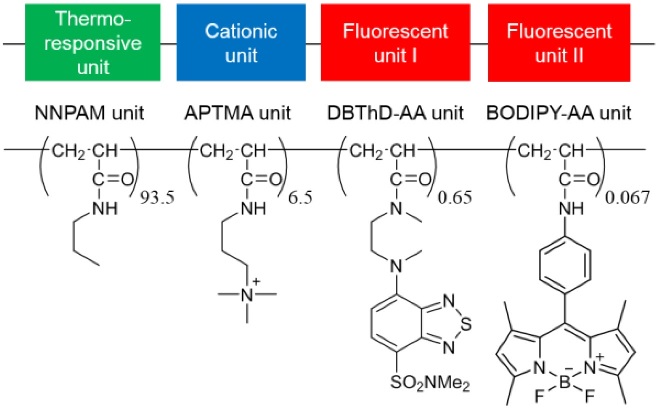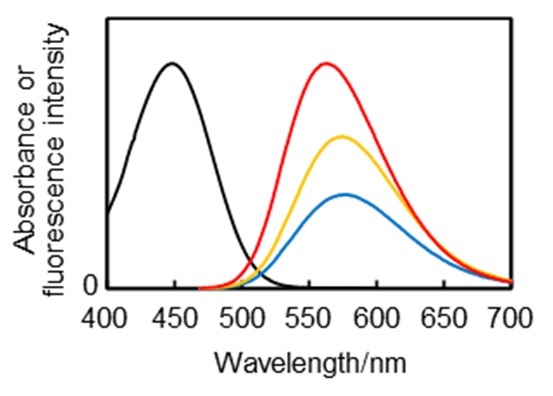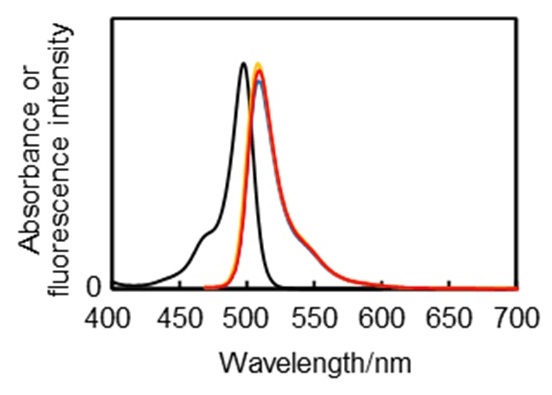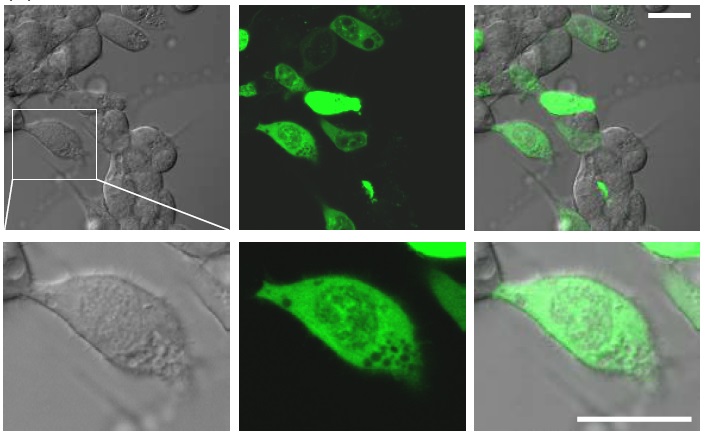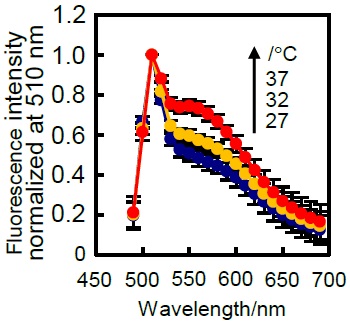Fluorescence probe to measure temperature inside cells by fluorescence ratio Cellular Thermoprobe™ for Fluorescence Ratio
Date:March 23 2017Web Page No:80405

Funakoshi Co.,Ltd.
Cellular Thermoprobe™ for Fluorescence Ratio is a fluorescent probe that can be introduced into cells simply by treating cells with a 5% glucose solution containing the fluorescent probe, and measures the temperature inside the cell by the ratio of two fluorescences.
※ Learn more about ☞ Diffusive Thermoprobe™, which introduces fluorescent probes into cells by microinjection.
※ Learn more about ☞ Cellular Thermoprobe™ for Fluorescence Lifetime, which measures temperature inside a cell by fluorescence lifetime.
Confocal fluorescent images at excitation 473 nm and the emission 500-520 nm and 560-610 nm, and its ratiometric image (560-610 nm / 500-520 nm) was visualized in pseudocolor according to a separately acquired calibration curve.
- Above : intracellular temperature before and after addition of FCCP, an inhibitor of ATP synthesis
- Below : intracellular temperature before and after addition of norepinephrine, β-adrenergic receptor agonist
- Cell Function & Temperature
- Features
- Structure & Principles
- Absorption & Fuorescence Spectra of Fluorescence Unit 1 (DBThD-AA) & 2 (BODIPY-AA)
- Outline of Protocol
- Fluorescence Wavelength & Temperature Resolution in MOLT-4 cells
- Fluorescence Wavelength & Image in HEK293T cells
- FAQ
- Reference
- Video
- Product Information
Cell Function & Temperature
Temperature is physical quantities that controls all chemical reactions in cells. Chemical reactions involving exothermic or endothermic reactions at a specific site in cells to carry out cell-function induce local temperature-change. Therefore, the intracellular temperature distribution reflects the thermodynamics and function of intracellular molecules. From the medical perspective, it has been reported that pathological cells such as cancer cells have enhanced thermogenesis. Therefore, understanding the intracellular temperature distribution is expected to contribute to a better understanding of cellular functions and to the development of new diagnostic and therapeutic methods.
Features
- Cellular Thermoprobe™ for Fluorescence Ratio can be introduced into cells by treating cells with a mixture of 5% glucose solution.
- It can be introduced into both adherent and suspension cells by incubating cells with Thermoprobe™ solution.
- It can be introduced into cells in a 10-20 minute reaction.
- The temperature detection range is between 28-44°C, and can detect temperature differences as small as 0.01-0.25°C.
- Spatial resolution with confocal laser microscopy is 240 nm, which can detect temperature differences inside cells.
- Example of observation conditions:
Confocal laser microscope Excitation light: 473 nm, Fluorescence wavelength: 500-520 nm (BODIPY-AA) and 560-610 nm (DBThD-AA) - Temperature measurements with Cellular Thermoprobe™ for Fluorescence Ratio are negligibly affected by intracellular ionic strength, pH, protein content and viscosity.
- Because fluorescence ratio is used, temperature is not affected by the local concentration of Thermoprobe™ and can be accurately measured.
- Solubility: Soluble in water
- Appearance: Yellow powder
Structure & Principles
Cellular Thermoprobe™ for Fluorescence Ratio is composed of thermo-responsive unit (NNPAM), cationic unit (APTMA), fluorescent unit 1 (DBThD-AA) and fluorescent unit 2 (BODIPY-AA). When a probe solution is at low temperature, fluorescent is weak due to the presence of water molecules in the structure. However, at high temperature, the hydrophobic interaction of thermo-responsive unit causes the probe to become small and rounded, so that water molecules are excluded from the probe and strong fluorescence is emitted. In addition, the incorporation of cationic unit allows to be spontaneously introduced into cells in a short time. The fluorescence intensity of fluorescent unit 1 changes with temperature, while fluorescent unit 2 is not affected by temperature changes. Therefore, the fluorescence intensity ratio of DBThD-AA and BODIPY-AA enables accurate temperature measurement in a concentration-independent manner.
Absorption & Fuorescence Spectra of Fluorescence Unit 1 (DBThD-AA) & 2 (BODIPY-AA)
- Black: absorption spectra in acetonitrile
- Red: fluorescence spectra with excitation at 458 nm in ethyl acetate
- Yellow: fluorescence spectra with excitation at 458 nm in acetonitrile
- Blue: fluorescence spectra with excitation at 458 nm in methanol
Outline of Protocol
- Add 20 μl of ultrapure water to 200 μg powder and dissolve.
- Dilute with 5% glucose solution.
- Add Cellular Thermoprobe™ for Fluorescence Ratio in 5 % glucose solution to cells.
- Incubate the cells at 25℃ for 10-20 min.
- Wash the cells and add culture medium.
- Observe with a fluorescence microscope having a cage incubation chamber.
Fluorescence Wavelength & Temperature Resolution in MOLT-4 cells

Fluorescence Wavelength & Image in HEK293T cells
FAQ
Q-1 : Are temperature changes clearly visible in fluorescence images?
A-1 : As shown in the data sheet, the intensity of DBThD-AA-derived fluorescence will appear visually stronger when an appropriate filter is used. However, the actual temperature changes are often visible as larger changes by taking the ratio of the two wavelength images.
Q-2 : What types of cells can it be used on?
A-2 : We have confirmed that it can be transfected into adhesive cells HEK293T, HeLa, C2C12, A431, and RAW264.7. We have also confirmed that it can be transfected into MOLT-4, a planktonic cell line. In primary cultured cells, we have also confirmed that it can be applied to brown adipocytes derived from stromal vascular fraction (SVF) derived from rat or mouse scapula tissue.
Q-3 : When I get a fluorescence intensity ratio image, there is a lot of noise and it does not look good.
A-3 : Before getting a fluorescence intensity ratio image, noise-reduction process such as average filter or background-process can reduce noise in the fluorescence intensity ratio image.
Q-4 : Is there any effect of fading?
A-4 : It depends greatly on the performance of your microscope system, however we have not noticed any fading with a typical confocal laser microscope. If you are concerned about fading, it is possible that the amount of probe introduced into cells is too small or the filter is not appropriate.
Q-5 : Thermoprobe™ cannot be introduced into cells.
A-5 : There are several possibilities: one is a problem with the optics, such as wavelength not being correct. Another possibility is high background due to high autofluorescence of the culture medium or insufficient washing after Thermoprobe™ treatment. For example, it would be good to check if the cells can be observed under the microscope in a 150 mM KCl solution with Thermoprobe™ dissolved at 0.01-0.1 w/v%, and if the fluorescence intensity ratio changes in response to temperature. If it is visible in solution but not in cells, it may not be available for those cells.
Q-6 : Is it possible to observe cells without temperature control on a microscope?
A-6 : In order to monitor temperature changes in cells, it is difficult to use a microscope without the ability to control temperature on a microscope stage.
Reference
- Uchiyama, S., et. al., Analyst, 140, 4498~4506 (2015).
- Uchiyama, S. & Gota, C. Reviews in Analytical Chemistry, 36, 1, from doi:10.1515/revac-2016-0021 (2016).
- Tsuji, T., et. al., Sci Rep., 7(1), 12889. doi: 10.1038/s41598-017-12634-7 (2017).
- Uchiyama S., et. al., Chem Commun (Camb)., 53(80):10976~10992. doi: 10.1039/c7cc06203f (2017).
Cited by
- Senthivinayagam, S., et. al., Mol. Matab., 101130. doi: 10.1016/j.molmet.2020.101130 (2021).
- Kimura, H., et. al., Sci Rep., 7(1), 12978. doi: 10.1038/s41598-017-13563-1 (2017).
Video
Product Information
[Date : December 13 2025 00:07]
| Detail | Product Name | Product Code | Supplier | Size | Price | ||||||||||||||||||||||||||||||
|---|---|---|---|---|---|---|---|---|---|---|---|---|---|---|---|---|---|---|---|---|---|---|---|---|---|---|---|---|---|---|---|---|---|---|---|
|
Cellular Thermoprobe for Fluorescence Ratio DatasheetThis may not be the latest data sheet. |
FDV-0005 | FNAFunakoshi Co.,Ltd. | 200 µg | $180 | |||||||||||||||||||||||||||||||
|
|
|
||||||||||||||||||||||||||||||||||
|
Cellular Thermoprobe for Fluorescence Ratio DatasheetThis may not be the latest data sheet. |
FDV-0005 | FNAFunakoshi Co.,Ltd. | 3x200 µg | $480 | |||||||||||||||||||||||||||||||
|
|
|
||||||||||||||||||||||||||||||||||
[Date : December 13 2025 00:07]
Cellular Thermoprobe for Fluorescence Ratio
DatasheetThis may not be the latest data sheet.
- Product Code: FDV-0005
- Supplier: FNA
- Size: 200µg
- Price: $180
| Description |
Membrane-permeable, temperature-sensitive fluorescent probe. It can measure intracellular temperature distribution by fluorescence ratio of two wavelengths. |
||
|---|---|---|---|
| Storage | RT | CAS | |
| Link |
|
||
Cellular Thermoprobe for Fluorescence Ratio
DatasheetThis may not be the latest data sheet.
- Product Code: FDV-0005
- Supplier: FNA
- Size: 3x200µg
- Price: $480
| Description |
Membrane-permeable, temperature-sensitive fluorescent probe. It can measure intracellular temperature distribution by fluorescence ratio of two wavelengths. |
||
|---|---|---|---|
| Storage | RT | CAS | |
| Link |
|
||
CONTACT
export@funakoshi.co.jp
- ※Prices on our website are for your reference only. Please inquire your distributor for your prices.
- ※Please note that Product Information or Price may change without notice.

